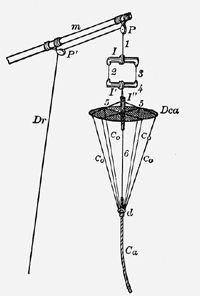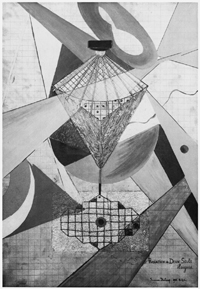click to enlarge
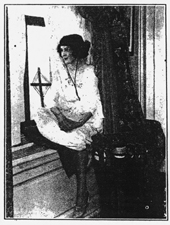
“Send Me a Kiss by Wireless”,
QST, May 1922, p. 54 (photo: Underwood & Underwood) This
picture was reproduced in many newspapers across the country during
the radio boom. The male radio amateurs reacted with new proposals
for captations, like “See the Shaft – on the Variometer”
Everything that we call electronic mass media today begins with the sending and receiving of signals without any material connection, with the miracle of “wireless” that started shortly before 1900. From 1920 on, this transmission technique of then primarily strategic military use develops into radio broadcasting. As a result, material things disappear from mass distribution and the media turn into something “immaterial”. The uniformity of all products for all people caused by industrialization – as is expressed by the lexical term “ready made” – is only a preliminary stage towards a globally synchronized perception of a “radio-made” experience world. With the Greenwich time signal, which has been broadcast by radio transmission from the tip of the Eiffel Tower since 1910, this immaterial synchronization reaches all of Europe. And only a year after that a time signal is transmitted around the world through a chain of wireless stations.
Radio is not a word but a prefix. It denotes something that emits radially: from one point to many, carried by electromagnetic waves. According to the intentions of its inventors, radio transmission ought to deliver a signal from a transmitter to one single receiver. But despite all efforts they cannot mold the Hertz waves to fit into the concept of cable connections: the signal would always reach more receivers than it was supposed to. Thus, the military becomes concerned with the secrecy of their radio messages. At the same time, this circumstance delights the radio amateurs who devotedly listen to everything their homemade apparati allow them to receive way before actual radio programs emerge. These craftsmen and amateurs form the basis of the unexpectedly developing radio boom starting in 1920, which creates a medium nobody had planned. The same happens again in the 1980s when hackers, being the first private users of the global computer and telecommunications network, represent the forerunners of the Internet boom of the 1990s.
Indeed, radio – and therefore the beginning of all electronic mass media – is invented by receivers, not by broadcasters. One might modify Duchamp’s famous quote that the onlookers make the pictures: “Ce sont les récepteurs, qui font les médias.” And even though today it seems as if the broadcasters alone possessed all power over the mass media, there is an almost anarchical criterion, on which all is based and in which the power of the receivers has been preserved: In TV ratings are everything.
click to enlarge
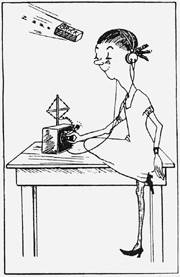
“Radio Girl”, QST,June 1922, p. 68. Sketch of an
amateur from Poduch, NJ, reacting to the photograph
“Send Me a Kiss by Wireless,” including a reader’s letter (excerpt)
: “This radio game is getting too much punk lately.
Why, pick up any newspaper and take a look at some of the radio
pictures they are printing. Swell janes talking into sets that have
no tubes in the sockets.” Signed: “Your brass pounder. Amplifier
Ambrose.”
How could the power of the receivers be great enough to turn the entire media machine upside down and change it from a strategic into a distributive system? What fascination initiated all that constitutes our present-day electronicized worldview? For one thing, there is the “bricolage” or fiddling with ominous elements such as wire, lacquer, magnets, crystals and so on. Under one’s own hands an apparatus comes into being that brings forth strange signals from the nothingness of the air. The enigma lies in how something develops out of nothing and how this something is interconnected with the rest of the world. For there are signals telling of news from far away, of temperatures, stock market rates, other radio amateurs and sometimes even of sensations like the SOS signal of a distressed ship. The power of the receivers lies in the invention of listening – first there were the listeners, next broadcasting stations emerged addressing this unknown and scattered community, then a radio boom arose, which was very much comparable to today’s internet boom. During the first years of radio, listeners would experience and describe receiving as global raptures of listening to boundless spaces. ”
“…to feel at home in the surge, in the motion, in the fleeting and infinite. Not to be at home and yet to feel at home anywhere; to see the world, to be in its center and to be concealed from it.” These words may serve to describe the listening experience that would fascinate so many from the time of the amateurs to the beginning of radio. Yet they come from Charles Baudelaire and relate a flaneur’s experience in the anonymous mass of a modern metropolis, “from this universal communion he gains a unique sort of inebriation.”(1)
click to enlarge
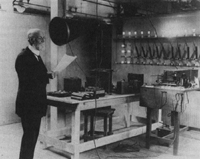
The first
radio lecture being delivered by radio from Tufts University, 1922.
Initially, radio is being promoted as a great instrument of education
for the masses. In the USA it is announced that the “University
of the Air” will have more students than all universities of the
country combined. At the first radio lecture at Tufts University
in 1922 it looks as if Freud himself speaks into the apparatus of
the soul – should it be viewed as a premonition of the libido’s
might, which would ultimately eliminate all educational value from
mass media? (see: Susan J. Douglas, Inventing American Broadcasting
1899-1922, Baltimore and London: Johns Hopkins UP, 1987, esp.
pp. 292-314)
The poet is a particularly sensitive receiver who by creating poetry becomes a sender himself. He bridges the centuries in the same way as it is depicted by Baudelaire’s marine metaphor of “Lighthouses” signifying intellectual authorities that send each other signals through the ages. What if the “universal communion” turned into a universal communication?
Many a time Baudelaire meets Baudrillard back to back on the shelves of a well-arranged private library. But beyond all alphabetical alliterations, premonition and abgesang of the sender’s power meet when Baudrillard writes in his “Requiem for the media”: “In the symbolic exchange relation, there is a simultaneous response. There is not transmitter or receiver on both sides of a message: nor, for that matter, is there any longer any ‘message’. […] Thus, the receiver (who in fact ceased to be one) intervenes here at the most essential level” by a “subversive reading” of the transmitter.(2)
It is exactly one such subversion of the broadcaster’s power through the receiver that 20 years before Baudrillard had been undertaken by John Cage’s “Imaginary Landscape No.4”: 24 performers convert 12 radios from reception to production devices. Something quite similar had already been done with record players in the 1939 piece “Imaginary Landscape No.1.” The transformation of a receiving device into a source of continuous original production has become an everyday aspect of mass entertainment in the era of the Techno-DJs. “Do you remember your thinking at the time?” Cage is asked. “Yes, my thinking was that I didn’t like the radio and that I would be able to like it if I used it in my work. That’s the same kind of thinking that we ascribe to the cave dwellers in their drawings of frightening animals on the walls – that through making the pictures of them that they would come to terms with them.”(3)
It seems as if media and machines have replaced wild beasts in the way they are depicted in art and literature of the 19th and 20th century: dangerous and fascinating, they cannot be conquered by the individual but are at the same time indispensable for the nutrition of the whole of the entire human society. The hoard of those, who are avantgarde fighters in the field of media and machines, is as purely male by definition as any prehistorical group of animal hunters.
One of the most famous wild beasts is Herman Melville’s “Moby Dick”. Here, the danger lurks in the deep – of the soul and of the sea – and both confront each other in such a dramatic way that the book becomes a world success. The metaphor of wild nature is replaced by technology in Melville’s almost unknown fantastic narration “The Paradise of Bachelors and the Tartarus of Maids” of 1852. It describes a bizarre world that comprises nine bachelors and a large machine, which is operated by lonely, freezing virgins and produces some sort of spermatozoid liquid from old clothes. Jean Suquet pointed out that the narration constitutes a counterpart to the “Bachelor Machine” of the Large Glass. Both agree even in details such as names and numbers, even though it is certain that Duchamp had never read Melville.(4)
It may seem almost natural that all radio amateurs and computer hackers of the 20th century are true bachelors. They are “amateurs”, i.e. lovers in the proper sense, who already get confused by the fact that with the opening up of their domain to a mass audience women might now be present on the air and on the Internet, respectively. This way, the previously celibatic purity of technology is sacrificed, making space for a playground of media-erotomaniac identity games that are based on the technical ambivalence of distance and proximity.
But in the depth of language the secret goal of all hackers is buried: The “matrix” is the net of all nets and at the same time it is the mother’s womb. The painful rebirth of Neo alias Keanu Reeves into the real world as shown in the movie “The Matrix” (1999) offers the best visualization of this double meaning. Perhaps, the ultimate goal of all those hackers, amateurs and lovers in regard to their media could be compared to Paik’s “Danger Music”(5)for Dick Higgins: to crawl into the vagina of a live female whale in order to become one with what separates them from the world – thereby, without being explicitly sexual, reinstating the prenatal experience of absolute seclusion in a man-made natural environment. But alas, there is no escape: ultrasound will detect the embryo in a mother’s womb as well as the whale in the depths of the sea. Technology advances into realms that previously were considered unknowable and therefore remained in the unconscious mind.
click to enlarge
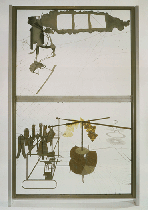
Marcel Duchamp,The Bride Stripped
Bare by her Bachelors, even (The Large Glass),
1915-23© 2000 Succession Marcel
Duchamp ARS, N.Y./ADAGP, Paris
In the Large Glass the bachelors and the bride stand divided by a translucent horizon, yet they are connected through “wireless”.(6)Media technology surpasses the horizon between the two irreconcilable worlds – just like in Grandville’s enigmatic woodcarving from 1844, which shows a letter shooting up from the depths of the sea on a spiraling cable. Here, reference is made to the first submarine telegraph cable.(7)
click to enlarge
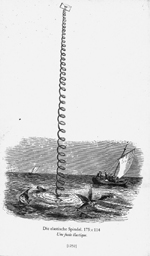
Jean-Jacques Grandville, “Une fusée élastique,
” in: Un Autre Monde, Paris:
H. Fournier, 1844
Is it coincidence that during the last years of the 19th century two disciplines that – due to their lack of physical substance – the ordinary mind found unimaginable are investigated almost synchronous: wireless transmission technology and psychoanalysis? Both of these are the last great gifts of the 19th to the 20th century where they would have enormous effects. Both have lead to a new form of non-dialogic one-way speech that clearly assigns the sender and the receiver their respective separate sides of couch and microphone. And both turn the flow of natural language into a new form of “automatic” speech. The surrealists utilized this phenomenon in their “écriture automatique”, which, in turn, is based on the futurist’s “wireless imagination”, a language lacking any regard to syntax and punctuation. The difference between the approaches of the surrealists and the futurists is that the latter refer to the electric, wireless medium while the former employ the psychological or even para-psychological meaning of “medium” as a model. In the libidinous and immaterial wireless connection between the bachelors and the bride of theLarge Glass technology and psychology are put to work together.
Like submarine commanders in the sea of the unconscious, bachelors of all ages and media send out signals through their machines, without even knowing that by doing so they are but trying to reach prospective brides. Though, strategically they seem just as helpless as the submarine Cage’s father, an inventor, had constructed. Cage compares his father without hesitation to Duchamp in that they were both “bricoleurs”.(8) The submarine, however, was never put to service in WW I, because it could be detected too easily due to the bubbles that would rise from it. This is why “… and bubbles on surface” is frequently heard from Cage in his readings and writings.
Thus is the state of the subconscious that it is nothing but a sunken cultural asset lurking deep down on the bottom of common sense where we can detect it through bubbles on the surface of the media.(9)
Today, the last adventures in an overly well-known world await the surfer in the depths of the Internet. He dives deep into the waves of the information tide, as did the radio amateurs who would lose themselves in the global waves of the ether. Only rarely he surfaces to obtain the bare necessities for survival from the world of “ready-made” goods.(10)
The ever-identical object from the world of mass-produced goods becomes obvious only through the attachment of a pseudo-indivduality to a single “ready-made” object. In the same manner, the world of “radio-made” information becomes distinguishable from static only through the random selection of a single one out of many signals. Since the appearance of “ready-mades”, producing and presenting as the basic principles of mass production have become as dubious as sending and receiving have for media technology since Cage’s “Imaginary Landscape No.4”. George Brecht follows Cage’s path with his “Candle piece for radios” and the concept of “listener as virtuoso”.(11)
But aren’t even the songs of whale recorded, as if they were messages encoded for us humans? Whenever a signal is sent man thinks it happened on his behalf.(12)
Certainly, the spiritualistic medium of occultism has – in part – been inspired by “wireless” technology. Yet it remains a pre-technological model, even if the shortcut between sender and receiver in a psycho-technology of make-beliefs may be comparable to the collaps of the sender-receiver model in the mass media according to Baudrillard.(13) But it is the privilege of artists to transcend the division of sender and receiver without losing their credibility. Thus, claims Duchamp, artists play a “mediumistic” role allowing the worth of a work of art to remain “completely divorced from the rationalized explanations of the artist. […] All in all, the creative act is not performed by the artist alone; the spectator brings the work in contact with the external world by deciphering and interpreting its inner qualifications and thus adds his contribution to the creative act.”(14) The work of art reaches the viewer like the signal reaches the listener, like the sonar reaches the whale.
click images to enlarge
- “Cage-type emitting antenna,
from: Henri Poincaré and Frederick Vreeland,
Maxwell’s Theory and Wireless Telegraphy,
New York, 1904, p. 142” (image from:
Henderson, cf. note 6, ill. no. 103) - Suzanne Duchamp, Radiationde Deux Seuls
Éloignés (Radiation of Two Lone Ones at a Distance),
1916-18-20. The combination of wireless technology
and erotic desire becomes more explicit in this work
by Suzanne than in her brother’s Large Glass.
According to Linda Dalrymple Henderson “The upper form
resembles a cage-type emitting antenna [see adjacent image]
and the lower gridded one implies a surface on which the
‘radiations’ are to be recorded. […] the theme seems to
echo that of the Large Glass: here an antennalike
‘Bride’ (Suzanne herself?) projects her message.”
(Henderson, cf. note 6, p. 112). The metaphor of an
electric or magnetic attraction between lovers has its
roots way back in the age of romanticism: In 1827,
Goethe told Eckermann “between lovers the magnetic
force is especially strong.” Around the same time,
the possibility of telegraphy via the “loving
needles” of two distant compasses synchronized by myserious
forces was seriously discussed.
Notes
 1. Charles Baudelaire, quoted after Wolfgang Kraus (ed.), Symbole und Signale: Frühe Dokumente der literarischen Avantgarde, Bremen 1961, pp. 46 – 47 (see also: Charles Baudelaire’s “The Painter of Modern Life,” in:The Painter of Modern Life and Other Essays, London: Phaidon, 1964, pp. 1-40; Charles Baudelaire, Paris Spleen, New York: Norton, 1988, transl. by Louise Varese)
1. Charles Baudelaire, quoted after Wolfgang Kraus (ed.), Symbole und Signale: Frühe Dokumente der literarischen Avantgarde, Bremen 1961, pp. 46 – 47 (see also: Charles Baudelaire’s “The Painter of Modern Life,” in:The Painter of Modern Life and Other Essays, London: Phaidon, 1964, pp. 1-40; Charles Baudelaire, Paris Spleen, New York: Norton, 1988, transl. by Louise Varese)
 2. Jean Baudrillard, “Requiem for the Media” (1972), in: For a Critique of the Political Economy of the Sign(Charles Levin, transl.), St. Louis, Mo.: Telos Press, 1981, pp. 164-84
2. Jean Baudrillard, “Requiem for the Media” (1972), in: For a Critique of the Political Economy of the Sign(Charles Levin, transl.), St. Louis, Mo.: Telos Press, 1981, pp. 164-84
 3. Richard Kostelanetz and John Cage, “A Conversation about Radio in Twelve Parts,” (1984) in: John Cage at Seventy-Five (Bucknell Review, v. 32, no. 2), Cranbury, NJ: Associated UP, p. 278 (pp. 270-302).
3. Richard Kostelanetz and John Cage, “A Conversation about Radio in Twelve Parts,” (1984) in: John Cage at Seventy-Five (Bucknell Review, v. 32, no. 2), Cranbury, NJ: Associated UP, p. 278 (pp. 270-302).
 4. Jean Suquet, Miroir de la Mariée, Paris 1973, S. 228 – 231. The term “bachelor machine” stems from the “Green Box” of 1934, Duchamp’s collected notes for his “Large Glass”. Numerous authors pick up on the term, applying it to a wide variety of phenomena, e.g. in: Michel Carrouges, Les Machines Célibatiares (1954), Paris 1975 and Gilles Deleuze & Félix Guattari, Anti-Oedipe, Paris: Editions de Minuit, 1972
4. Jean Suquet, Miroir de la Mariée, Paris 1973, S. 228 – 231. The term “bachelor machine” stems from the “Green Box” of 1934, Duchamp’s collected notes for his “Large Glass”. Numerous authors pick up on the term, applying it to a wide variety of phenomena, e.g. in: Michel Carrouges, Les Machines Célibatiares (1954), Paris 1975 and Gilles Deleuze & Félix Guattari, Anti-Oedipe, Paris: Editions de Minuit, 1972
 5. Nam June Paik, Niederschriften eines Kulturnomaden, Edith Decker (ed.), Köln 1992, p. 16
5. Nam June Paik, Niederschriften eines Kulturnomaden, Edith Decker (ed.), Köln 1992, p. 16
 6. cf. Linda Dalrymple Henderson, Duchamp in Context: Science and Technology in the Large Glass and Related Works, Princeton 1998, see esp. pp. 103-115: “Wireless Telegraphy, Telepathy, and Radio Control in the Large Glass”
6. cf. Linda Dalrymple Henderson, Duchamp in Context: Science and Technology in the Large Glass and Related Works, Princeton 1998, see esp. pp. 103-115: “Wireless Telegraphy, Telepathy, and Radio Control in the Large Glass”
 7. Jean-Jacques Grandville, “Une fusée élastique”, in: Un autre Monde, Paris 1848/49
7. Jean-Jacques Grandville, “Une fusée élastique”, in: Un autre Monde, Paris 1848/49
 8. Conversation of the author with John Cage, Cologne, 1987
8. Conversation of the author with John Cage, Cologne, 1987
 9. So to speak the “subconscious” (German: unterbewusst) is a Freudian misconstruction based on a misunderstanding of Sigmund Freud’s “unconscious” (German: unbewusst). For the notion of the unconscious topologically located “underneath” the conscious, to be found somewhere ‘down there’, like some kind of primeval sludge rising that resurfaces every now and then, is not in any way related to Freud’s concept of the unconscious. In fact, his writings call for a very different model of the relationship between the conscious and the unconscious, with the conscious arising from the unconscious, being enclosed by it while both are subjected to their mutual state of continuous correlation.(from an e-mail correspondence with Sigrid Schade).
9. So to speak the “subconscious” (German: unterbewusst) is a Freudian misconstruction based on a misunderstanding of Sigmund Freud’s “unconscious” (German: unbewusst). For the notion of the unconscious topologically located “underneath” the conscious, to be found somewhere ‘down there’, like some kind of primeval sludge rising that resurfaces every now and then, is not in any way related to Freud’s concept of the unconscious. In fact, his writings call for a very different model of the relationship between the conscious and the unconscious, with the conscious arising from the unconscious, being enclosed by it while both are subjected to their mutual state of continuous correlation.(from an e-mail correspondence with Sigrid Schade).
 10. E-mail correspondence with Sigrid Schade
10. E-mail correspondence with Sigrid Schade
 11. Both net-pop culture and art offer comparable experiments by which one’s entire lifestyle, from food to furniture to sex partners are organized via the internet; cf. Dirk Lehmann, “Überleben mit dem Internet”, in:Konr@d, December/January 1998 – 99, pp. 22 – 28 and Christian Jankowski, Let’s get physical/digital, Galerie Klosterfelde, Berlin June/August 1998; also: www.artnode.se/physical/digital
11. Both net-pop culture and art offer comparable experiments by which one’s entire lifestyle, from food to furniture to sex partners are organized via the internet; cf. Dirk Lehmann, “Überleben mit dem Internet”, in:Konr@d, December/January 1998 – 99, pp. 22 – 28 and Christian Jankowski, Let’s get physical/digital, Galerie Klosterfelde, Berlin June/August 1998; also: www.artnode.se/physical/digital
 12. George Brecht, Notebooks I – III, 1958 – 1959, Facsimile Editon, Dieter Daniels (ed.) with collaboration of Hermann Braun, Köln 1991, vol.. III, p. 111 and footnotes
12. George Brecht, Notebooks I – III, 1958 – 1959, Facsimile Editon, Dieter Daniels (ed.) with collaboration of Hermann Braun, Köln 1991, vol.. III, p. 111 and footnotes
 13. cf. Wolfgang Hagen, “Der Okkultismus der Avantgarde um 1900”, in: Sigrid Schade, Georg Christoph Tholen (eds.): Konfigurationen zwischen Kunst und Medien, with CD-ROM by Heiko Idensen (ed.), Paderborn 1999
13. cf. Wolfgang Hagen, “Der Okkultismus der Avantgarde um 1900”, in: Sigrid Schade, Georg Christoph Tholen (eds.): Konfigurationen zwischen Kunst und Medien, with CD-ROM by Heiko Idensen (ed.), Paderborn 1999
 14. Marcel Duchamp, English translation from the French quoted after: Michel Sanouillet and Elmer Peterson (eds.), The Writings of Marcel Duchamp, New York 1989, pp. 139f
14. Marcel Duchamp, English translation from the French quoted after: Michel Sanouillet and Elmer Peterson (eds.), The Writings of Marcel Duchamp, New York 1989, pp. 139f



